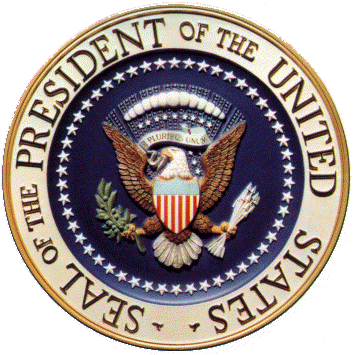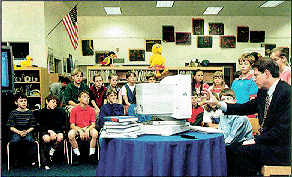

Welcome to the fall issue of Inside the White House. This newsletter is designed to keep you informed about some of the important issues being discussed in Washington D.C., both at the White House and on Capitol Hill. This issue focuses on computers and how you can explore the Internet and the Information Superhighway.
Many young people write to me about computers -- asking questions about the importance of technology and ways to use computers in the classroom and at home. I am pleased that so many young Americans are interested in these complex topics, and I hope this newsletter will help you learn and understand more about them.
My Administration is working in partnership with many organizations, businesses, and individuals to use technology to improve American education. Vice President Gore and I want to ensure that all children have access to the Information Superhighway by the year 2000 with computers and the finest educational software. By signing the Telecommunications Act of 1996, we have taken an important step toward connecting classrooms and libraries to the Information Superhighway. We are pleased that young people across the country are learning in ways that we never dreamed of as children.
This is an exciting time in our nation's history, and I hope that you
will continue to learn about the latest discoveries in computer
technology and seek new educational opportunities.

When you connect your computer to other computers with cable or through phone lines, you have become part of a "network." Some networks involve just a few computers, while others involve many. By using computers connected to the same network, people can send each other e-mail messages and exchange files. For example, scientists and researchers can share their work with colleagues through the computer instead of relying on phone calls, fax transmissions, or regular mail to transfer documents and other information. In fact, the Internet was developed especially for that purpose.
The Internet is a large network that connects tens of thousands of smaller networks. Created by the Unted States Department of Defense in the 1960s, the Internet provides a way for groups of computers to pool information, creating paths on what we now call the Information Superhighway. As the Internet has grown and more computer networks have become connected to one another, people have realized that this system has many exciting new uses. That's why the Internet is no longer used only by the Department of Defense -- research facilities, universities, and businesses have connected, as have families, students, teachers, schools, and others interested in broadening their horizons. Anyone can now become a part of the global Internet network.
The World Wide Web (WWW) is not a single thing or location. The term "Web" refers to the ever-growing collection of computers that are both connected to the Internet and loaded with special software that allows them to access and view information in a special format. Any computer user can browse the WWW if his or her machine has the correct software and is connected to the Internet. Using the WWW has two main advantages. First, the WWW uses an enormous array of pictures, graphics, sound, and video. Second, it contains links, known as "hyperlinks," that help users find other sources of information. By clicking on a "hyperlinked" topic, you can be immediately referred to other related information, such as pictures, videos, or sound clips -- perhaps even a web site on a computer in another country.

There are basically two ways to connect a computer to the Internet and then to the World Wide Web: by telephone modem or by direct connection to a computer network that already has access to the Internet. Once you are connected, you can "surf the ' net" for information about subjects ranging from rain forests to Impressionist art to President Clinton's economic policies. For example, if you had a school assignment on Abraham Lincoln, you could use the WWW to search and browse through hundreds of articles. The Web could help you look at portraits of Lincoln right on your screen. It could even allow you to chat electronically with a college professor who is an expert on past Presidents.
The computer is a powerful learning tool. Using the Internet and the WWW will help you learn about the world and communicate with many interesting people. This technology holds unlimited possibilities, so take the opportunity to get online and see what everyone is talking about.
Electronic mail, or e-mail, is the name given to written messages that are passed from one computer user to another through computer networks or over telephone lines via modems. E-mail is similar to regular mail, but the computer and telephone lines take the place of the postal service.
The White House began receiving e-mail messages via the Internet on June 1, 1993, and on January 31, 1996, the White House received its one millionth electronic message. Another record was set in November 1995, when -- for the first time in history -- the number of incoming e-mail messages exceeded the volume of regular postal mail sent to the President. During one ten-day period, President Clinton received over 55,000 individual e-mail messages!

The fast-paced global marketplace demands new skills from America's workers and students, and many recent studies have shown that the use of technology in the classroom helps students to get a better education in language, art, math, social studies, and science. One of President Clinton's highest priorities is ensuring a bright future for America's children, and he believes that classroom computers and the World Wide Web will soon become as important to teachers and students as textbooks.
In his 1996 State of the Union address, President Clinton called on every American to join him on a mission to make our nation's children technologically literate, to connect every classroom and every library in the country to the Internet, and to equip schools with high-quality computers, trained teachers, and creative software.
Many schools and individual classrooms have acted on President Clinton and Vice President Gore's challenge to use computers and the Internet in exciting ways. Education organizations have joined together to support "21st Century Teachers," an initiative to make teachers as comfortable with a computer as they are with a chalkboard. Teachers and students have created "web sites" on the WWW -- places where other computer users can visit to learn about school activities and accomplishments.
One such site was created by Steve Rothenberg's sixth grade class at the Walker School in Concord, New Hampshire. On their "home page," you can learn interesting facts about students, read the latest issue of the class newsletter, or enjoy students' poems and reports. President Clinton visited the Walker School on February 2, 1996, and a record of his trip was posted on the web page. With a click of the mouse, an Internet user could find out what Walker School students thought of the President's trip and see pictures of sixth graders showing him their web site.
Another school taking advantage of the opportunities offered by the Internet is Riverside Elementary School in Shreveport, Louisiana. By reading the school's home page, parents can get notes from the principal and teachers, children can see other students' drawings, athletes can learn about Riverside's running club, and everyone can check on the latest events taking place at the school.
School web sites like these can benefit everyone by giving students a forum to showcase their latest projects, enabling parents to be easily involved in their children's education, and allowing the world to see that schools in the United States are committed to educating young people to face the challenges of the 21st century.

"By the end of this school year, every school in California, 12,000 of them, will have access to the Internet and its vast world of knowledge...fully 20 percent of California's classrooms, 2,500 kindergarten, elementary, middle, and high schools, from one end of the state to the other will be connected for computers. If that can be done in California, we can do it in the rest of America."President Bill Clinton, September 21, 1995
NetDay is an important part of the technological explosion that is connecting schools across the country to one another and to the Internet and WWW. When every school in America is connected, all students will be able to access speeches, articles, and information for school reports, share valuable data and information with one another, and learn skills that will help them to get jobs and succeed in our fast-paced economy. To find out if there is a NetDay in your state, visit the NetDay home page at http://www.netday96.com.
Computer Terms
A chat group is a group of people who send messages to one another online about a subject of common interest. For example, if you are excited about music, you can join a chat group to talk to other people who love music.
A cursor is usually an arrow or hand with a pointing finger that moves across the screen pointing to or highlighting text or other locations.
A home page on the World Wide Web is the same as a cover on a book; it's the first "page" you see at a World Wide Web address. All other pages are accessible by following links from the home page.
An icon is a small picture intended to represent something (a file, directory, or command). Using your mouse, you can point your cursor at an icon, click on it, and open a file or start an application.
A modem is an electronic device that connects your computer to the telephone lines. If you have a modem, you can use an online service to access the World Wide Web.
A mouse is a device that connects to your computer and helps you direct your cursor on the screen. It is called a mouse because it's small, fits in the palm of your hand, and the wire connecting it to the computer looks like a mouse's tail.
If you are "online," you are connected to the Internet, sending and receiving data.
If you can imagine the Internet as an "ocean" of information, you can imagine yourself as a "surfer" on the "waves" as you explore areas of interest. The World Wide Web, with its graphics and sound, makes it even more fun to "surf the 'net."
A web site is a location on the WWW where you can find certain information. For example, to find out more about President Clinton, you could go to the White House's web site.
White House Educational Technology:
http://www.whitehouse.gov/WH/EOP/OP/edtech
21st Century Teachers:
http://www.21ct.org
Department of Education:
http://www.ed.gov
The United States House of Representatives:
http://www.house.gov
The United States Senate:
http://www.senate.gov